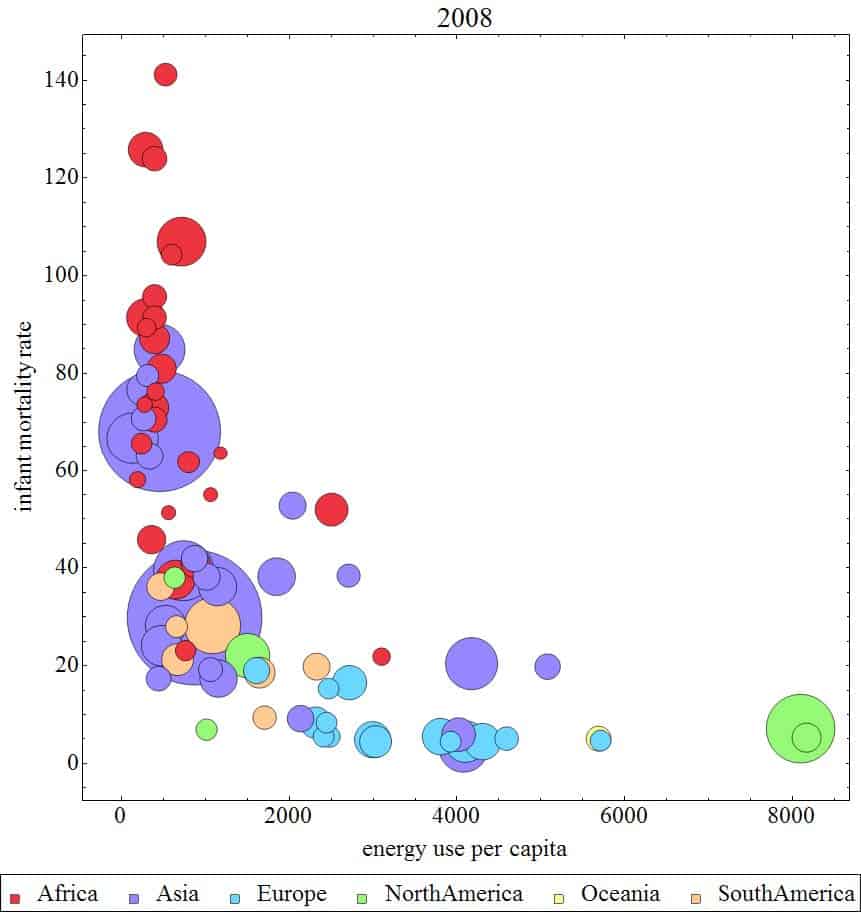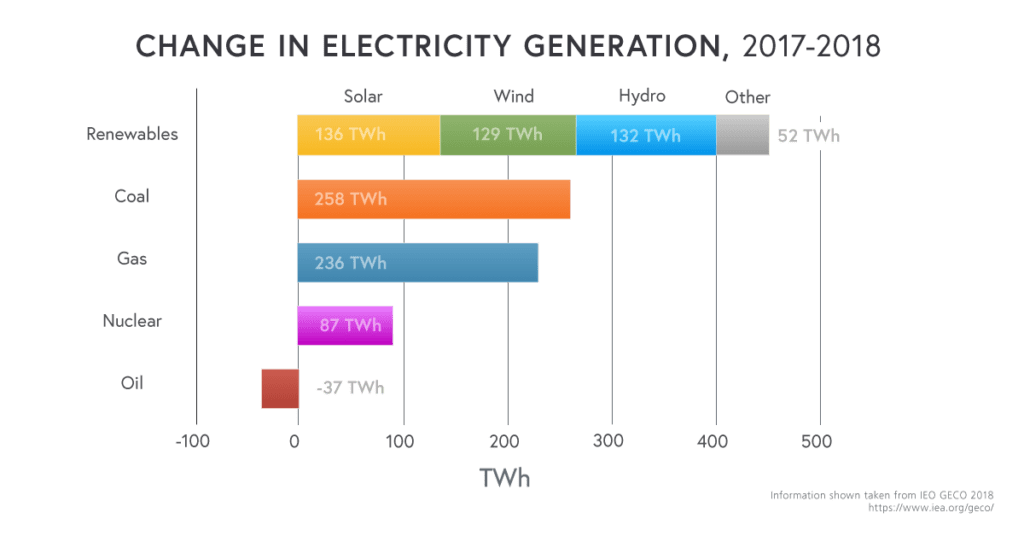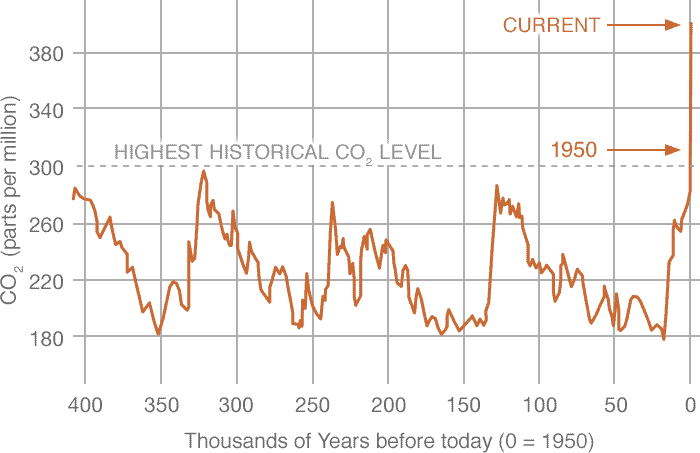Chapter 1
We all use energy in our lives, and not just for sustaining our human biology in waking, walking and wondering. To look at this website requires electrical energy. The energy to make the device you’re reading on had to come from somewhere. If you own a vehicle, you probably have to charge it or fill it with gas to get around.
There are many kinds of energy, and humanity has become pretty good at getting and converting energy from a lot of different sources. We’ve also started using more of it over time.
Primary Energy Sources

One of the types of energy everyone is most familiar with, electrical energy (or electricity), is actually a secondary energy source. The reason is that we have to produce it through some other means, and some of those means (primary energy sources) are in the pie chart above.
For example, we can turn turbines with flowing water, and the spinning turbine can then generate electricity. This is known as hydroelectric energy.
Nuclear energy takes advantage of Einstein’s famous equation, E=mc2, where mass (m) is converted to energy (E) during the splitting of an atom (nuclear fission). This releases huge amounts of heat that can be used to boil water into steam, which can then turn a turbine to generate electricity.
A much cleaner form of nuclear energy involves putting atoms together (nuclear fusion). Fusion is the reaction that powers our sun, and needs intense heat and pressure to happen, so it’s still under development. However, it’s seen great progress in recent years.
Coal, oil and gas are called fossil fuels, because they are produced from plants and animals that have decayed over hundreds of millions of years. As you can see from the above pie chart, we get a huge portion of our energy from burning fossil fuels. Burning fossil fuels releases energy that can produce steam, turn a turbine, and again give us electricity. It can also just produce motion, as in internal combustion engines.
Wind energy takes advantage of the Earth’s breeze to spin turbines and—you guessed it—generate electricity.
Solar energy is named after the latin word solaris, meaning “of the sun”. There are many ways of using the sun’s energy, ranging from using it to heat homes and industrial processes directly, or to heat molten salts and water for electricity. There are also ways to convert solar energy directly into electricity.
Solar photovoltaic energy takes advantage of the photoelectric effect, where an electrical current flows as a result of the sun shining on specific kinds of materials.
Think photo=light and volt=electricity. If you’ve ever seen a solar panel, that’s an example of solar photovoltaic energy, and we’ll see that it plays an important role in meeting the world’s anticipated energy needs.
There are many other ways to generate energy; this is just a sample of the main ways we get the energy for all the things we do around the world.
Future Energy Demands
Humanity’s need to use energy is not going away. In fact, our energy usage keeps growing. According to the International Energy Agency, the world’s energy consumption in 2018 increased at almost twice the rate of growth since 2010, needing an additional generation of 1000 TWh (a trillion kilowatt-hours, or about how much energy it would take for everyone on Earth to run a hairdryer for four days straight).
The 2018 World Energy Outlook reports that global energy demand is expected to increase by more than 25% by 2040.
These projections are conservative in the sense that they assume humanity doesn’t drastically increase its energy usage, particularly in third-world and developing countries. However, we can and should do better than that, because we need to strive to improve the living conditions of everyone on Earth. An investigation of the data reveals that GDP, life expectancy, and infant mortality statistics all improve with increased energy use per person. Bottom line: everything gets better with more energy.
“A first world lifestyle requires about 10 kW per person. For 10 billion people, humanity needs to generate 100 terawatts. Achieving this is a moral imperative; achieving it sustainably requires civilization scale deployment of solar energy production infrastructure.”


To really improve the living conditions of every human on the planet, then, we need to increase energy production by about five times by 2100.
This would require a heroic effort, and amounts to a new 1 GW power plant starting and maintaining operation every day.
This energy has to come from the different sources mentioned above. Some of them are non-renewable, meaning they don’t regenerate faster than we use them. The graph below shows change in how the electricity we used was generated in 2018.

A many-pronged approach is needed to try and meet the energy demands of tomorrow. As we start to deplete our fossil fuel reserves, we can see that we’ll need much more energy from renewable sources of hydro, wind and solar photovoltaics (solar energy).
There’s another big reason we want to move away from our dependence on fossil fuels, though.
Alternative Energies to Minimize Climate Change
The average temperature of our planet is rising, a phenomenon known as global warming.
The Earth’s climate has always undergone cycles, but what we’re seeing is much bigger than the ebb-and-flow throughout history. Scientists have estimated that human activity from industrialization since the late 19th century has caused about 1.0 C of global temperature change.
What’s the cause for this change? Our planet has a natural greenhouse effect. The sun heats up the land, oceans, and atmosphere. Some of this energy escapes back into space, but parts of it are also captured in different molecules that keep all this thermal energy cycling in the atmosphere. These molecules are known as greenhouse gases, and include carbon dioxide (CO2), water vapour (H2O), methane (CH4), Chlorofluorocarbons (CFCs) and others.
Carbon dioxide is one of the most prevalent, and one that humans have generated a lot of through the burning of fossil fuels. The graph below shows just how much we’ve changed the amount of carbon dioxide in the atmosphere. In 2018, energy-related carbon dioxide emissions rose to a historic high of 33.1 Gt (Gigatons).

“… atmospheric CO2 has increased since the Industrial Revolution” Image source: NASA
The effects of global warming and climate change are widespread. Higher carbon dioxide leads to ocean acidification, which devastates aquatic life. Higher temperatures melt the polar ice caps, raise the sea level, and cause huge changes to global weather patterns. We’ve already seen impacts such as increased drought or heavy precipitation in regions not equipped to deal with it. Temperature extremes cause species loss and extinction, not to mention the risks to health, livelihood, food security, water supply and economic growth.

IPCC 2018 report on p.13, showing the impacts and risks of global warming for different systems. Image Source
Many nations have recognized the need to take action to prevent climate change. The Paris Agreement was ratified in 2016 with the goal of ensuring global temperature rise remains below 2℃ as well as strengthening our ability to respond to climate change. Since then, it’s become clear that even more efforts are needed. A 2018 report by the Intergovernmental Panel on Climate Change (IPCC) concluded that we need to keep the global temperature rise to 1.5℃ if we really want to avoid the worst impacts of climate change.
Combating climate change is no easy task. According to the World Energy Outlook, the path to keeping our sustainable development goals will require “convergence of cheaper renewable energy technologies, digital applications and the rising role of electricity.”
Solar energy is a central part of the strategies toward a sustainable future.
Solar energy is anticipated to play a crucial role, not only in meeting the world’s energy needs, but also in minimizing climate change.
Breakthroughs are making solar photovoltaics more and more efficient. They’re the fastest growing resource for power generation (the worldwide photovoltaic electricity in 2014 was 40x that of 2006) . They also show the highest power density among all the renewable energy options. Add to this the fact that they don’t produce any pollution during their operation, have low maintenance costs, and run off of our warm G2V type star that will shine for billions of years to come, photovoltaics emerge as an essential part of our energy future.
